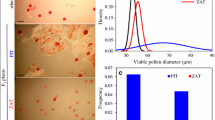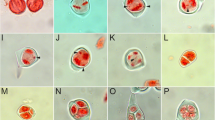Abstract
In order to exploit the induced female 2n gametes for cassava (Manihot esculenta) breeding, a detailed histological observation of female gametogenesis was conducted to correlate with the morphological characteristics of inflorescences and female flower buds. The SC5 gynoecia at the stage of prophase I were selected for unreduced megaspores induction with 0.3 % colchicine and 1 % dimethyl sulfoxide-soaked cotton plugs for 2 days. The resulted female cyathia were artificially pollinated with ploidy-level mixed pollens of SC10. Out of 250 hybrid progenies, two plants which exhibited morphological variations were confirmed as sexual tetraploids by flow cytometry and chromosome counting. Our results demonstrated that induction of 2n gametes combined with hybridization can be an effective approach for sexual tetraploid production for cassava.




Similar content being viewed by others
References
Alves AGC (2001) Cassava botany and physiology. In: Hillocks RJ, Thresh JM, Bellotti AC (eds) Cassava biology, production and utilization. CABI, Wallingford, pp 67–90
Barcaccia G, Tavoletti S, Mariani A, Veronesi F (2003) Occurrence, inheritance and use of reproductive mutants in alfalfa improvement. Euphytica 133:37–56
Bonierbale M, Guevara C, Dixon AGO, Ng NQ, Asiedu R, Ng SYC (1997) Cassava. In: Fuccillo D, Sears L, Stapleton P (eds) Biodiversity in trust. Cambridge University Press, Cambridge, pp 1–20
Bretagnolle F, Thompson JD (1995) Gametes with the somatic chromosome number: mechanisms of their formation and role in the evolution of autopolyploid plants. New Phytol 129:1–22
Brownfield L, Köhler C (2010) Unreduced gamete formation in plants: mechanisms and prospects. J Exp Bot 62:1659–1668
Ceballos H, Okogbenin E, Pérez JC, Becerra LA, Debouck D (2010) Cassava. In: Bradshaw J (ed) Root and tuber crops. Springer, New York, pp 53–96
Cock JH (1982) Cassava: a basic energy source in the tropics. Science 218(4574):755–762
Consiglio F, Carputo D, Monti L, Conicella C (2004) Exploitation of genes affecting meiotic non-reduction and nuclear restitution: Arabidopsis as a model? Sex Plant Reprod 17:97–105
De-Paula OC, Sajo MG (2011) Morphology and development of anthers and ovules in Croton and Astraea (Euphorbiaceae). Nord J Bot 29(4):505–511
Dewitte A, Van Laere K, Van Huylenbroeck J (2011) Use of 2n gametes in plant breeding. In: Abdurakhmonov IY (ed) Plant breeding. InTech Open Access Publisher, Croatia, pp 59–86
Galbraith DH, Harkins KR, Maddox JM, Ayres NM, Sharma DP, Firoozabady E (1983) Rapid flow cytometric analysis of the cell cycle in intact plant tissue. Science 220:1049–1051
Gallo PH, Micheletti PL, Boldrini KR, Risso-Pascotto C, Pagliarini MS, Valle CB (2007) 2n gamete formation in the genus Brachiaria (Poaceae: Paniceae). Euphytica 154:255–260
Gleadow RM, Evans JR, Mccaffery S, Cavagnaro TR (2009) Growth and nutritive value of cassava (Manihot esculenta Cranz.) are reduced when grown in elevated CO2. Plant Biol 11:76–82
Hahn SK, Bai KV, Chukwuma R, Dixon AA, Ng SY (1991) Polyploidy breeding of cassava. In: Proceedings of the 9th symposium of the international society for tropical root crops, pp 102–109
Jennings DL, Iglesias C (2001) Breeding for crop improvement. In: Hillocks RJ, Thresh JM, Bellotti AC (eds) Cassava biology, production and utilization. CABI, Wallingford, pp 149–165
Kapil RN (1961) Some embryological aspects of Euphorbia dulcis L. Phytomorphology 11:24–36
Lai HG, Chen X, Li KM, Ou WJ, Ye JQ, Zhuang NS, Qin QL (2013) Meiotic observations of the microspore mother cells and unreduced diploidy pollen induction in Manihot esculenta. Chin J Trop Crops 34(5):821–828 (in Chinese with English abstract)
Li YH, Kang XY, Wang SD, Zhang ZH, Chen HW (2008) Triploid induction in Populus alba × P. glandulosa by chromosome doubling of female gametes. Silvae Genet 57(1):37–40
Mendiburu AO, Peloquin SJ (1977) The significance of 2n gametes in potato breeding. Theor Appl Genet 49:53–61
Nassar NMA, Ortiz R (2007) Cassava improvement: challenges and impacts. J Agric Sci 145:163–171
Nassar HNMA, Nassar NMA, Vieira C, Saraiva IS (1995) Cytogenetic behaviour of interspecific hybrid of Manihot neusana Nassar and cassava, M. esculenta Crantz, and its backcross progeny. Can J Plant Sci 75:675–678
Ogburia MN, Yabuya T, Adachi T (2002) A cytogenetic study of bilateral sexual polyploidization in cassava (Manihot esculenta Crantz). Plant Breed 121:278–280
Otto SP, Whitton J (2000) Polyploid incidence and evolution. Annu Rev Genet 34(1):401–437
Perera PIP, Quintero M, Dedicova B, Kularatne JDJS, Ceballos H (2013) Comparative morphology, biology and histology of reproductive development in three lines of Manihot esculenta Crantz (Euphorbiaceae: Crotonoideae). AoB Plants 5:pls046. doi:10.1093/aobpla/pls046
Qiu DB, Xie SW, Kong WM (1991) Megasporogenesis and development of embryo sac of Hevea brasiliensis. Chin J Trop Crops 12(1):1–9 (in Chinese with English abstract)
Ramanna MS, Jacobsen E (2003) Relevance of sexual polyploidization for crop improvement—a review. Euphytica 133(1):3–18
Sreekumari MT, Jos JS, Nair SG (1999) ‘Sree Harsha’: a superior triploid hybrid in cassava. Euphytica 106:1–6
Tokuoka T, Tobe H (1995) Embryology and systematics of Euphorbiaceaesens. lat.: a review and perspective. J Plant Res 108(1):97–106
Wang YR, Deng GS, Li Y, Jiang JZ, Sun YH (2010) Progress in the mechanism of colchicine function on the tubulin and its cytological effects. Acta Bot Boreal Occident Sin 30(12):2570–2576 (in Chinese with English abstract)
Wu H, Zheng S, He Y, Yan G, Bi Y, Zhu Y (2007) Diploid female gametes induced by colchicines in oriental lilies. Sci Hortic 114(1):50–53
Xiao YQ, Zheng SX, Long CL, Zheng L, Guan WL, Zhao Y (2007) Initial study on 2n-gametes induction of Strelitzia reginae. J Yunnan Agric Univ 22(4):475–479 (in Chinese with English abstract)
Younis A, Hwang YJ, Lim KB (2014) Exploitation of induced 2n-gametes for plant breeding. Plant Cell Rep 33(2):215–223
Zhang J, Guo JH, Chen XT, Wang Y, Wang WQ, Lai HG, Wu KX, Ni YY, Huang Q (2012) Technique for microscopical slides of cassava leaf for chromosome observation. Chin J Trop Crops 33(1):20–23 (in Chinese with English abstract)
Zhong C, Zhang SN, Yu XH, Li Y, Hou XL, Li SJ (2010) Studies on the Induction of 2n gamete in Chinese cabbage and the production of tetraploid by sexual polyploidization. Acta Hortic Sin 37(11):1789–1795
Acknowledgments
This work was financially supported by the National Nature Science Foundation of China (Grant No. 31360354), The National Basic Research Program (973 Program China (No. 2010CB126606), the Natural Science Foundation of Hainan Province (Grant No. 313041), the Hainan Province Major Science and Technology Project (ZDZX2013023) and The western plan and subject key areas construction project of Hainan university (ZXBJH-XK001).
Author information
Authors and Affiliations
Corresponding author
Rights and permissions
About this article
Cite this article
Lai, HG., Chen, X., Chen, Z. et al. Induction of female 2n gametes and creation of tetraploids through sexual hybridization in cassava (Manihot esculenta). Euphytica 201, 265–273 (2015). https://doi.org/10.1007/s10681-014-1207-0
Received:
Accepted:
Published:
Issue Date:
DOI: https://doi.org/10.1007/s10681-014-1207-0




